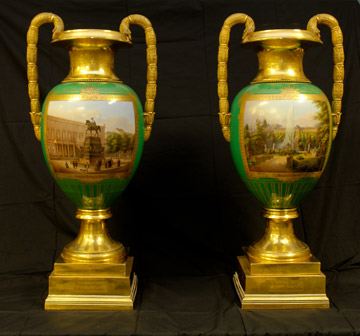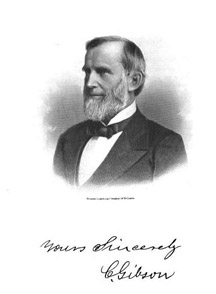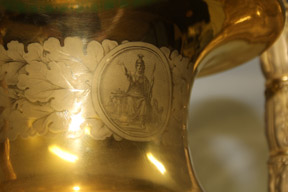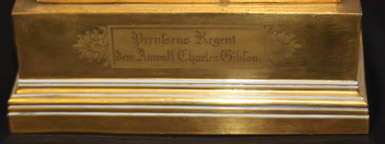
Prussian Vases, around 1860
JEFF-2016 and JEFF-2017
The artifact of the month for November is a pair of extremely large and elaborate vases that were presented to St. Louis lawyer Charles Gibson as a gift from the Prince Regent of Prussia Wilhelm I (later to be King of Prussia and the first Emperor of Germany). The gift was in recognition of Gibson's work representing the previous King of Prussia, King Friedrich Wilhelm IV, in a legal case that took place in St. Louis' Old Courthouse.
The vases are 37 ¼ inches tall, porcelain with a gilt porcelain base and arms and collar. The vases have paintings on both sides, one featuring the palace of Sanssouci and the new palace at Potsdam. The view of the new palace is based on a painting by Carl Daniel Freydanck, the house artist for the Königliche Porzellan-Manufaktur (KPM) or Royal Porcelain Manufactory in Berlin.(Christie's Auction Records, Sale 6398, Lot 482) The other vase features the palace and monument to Frederick the Great in Berlin. The tall gilt collars contain the seal of Prussia on one side and an allegorical figure of a woman, possibly meant to represent law or justice, on the other. Both are inscribed, "Prussia's Regent to the counselor Charles Gibson" and on the reverse, "The Unselfish Advocate of Justice."

The central issue of the legal case in St. Louis involved the embezzlement by a man named Frederick William Kuepper of about five thousand dollars from his position as postmaster in Wermelskirchen in Prussia on the 10th of April, 1849. Kuepper was the postmaster of the Royal Prussian Post Department, handling transfers of funds from one person and bank to another. Kuepper absconded from Prussia with the money he stole, and fled to St. Louis, where he soon died. The King of Prussia refunded the embezzled money to its rightful owners, then sued the administrator of Kuepper's estate, St. Louisan Felix Coste, for $7,000 for the original sum plus interest and damages. (King of Prussia v. Kuepper's Adm.)
The court proceedings began in 1851 with lawyer Charles Gibson acting for the King of Prussia and his close personal friend Edward Bates acting for the defense. When Gibson moved to St. Louis to start his career in law, Edward Bates was the first person he met at the dinner table of his boarding house and the men started a friendship that lasted for years. (Reavis, 489-495) In spite of their personal friendship, both lawyers fought for their clients-Bates insisting that the estate could not be held accountable for actions taken in another country and that the sovereigns of foreign nations had no right to sue in the state court system. (King of Prussia v. Kuepper's Adm.)
In his autobiography, Gibson wrote,
Prussia was then an absolute monarchy – the King alone issued and revoked all edicts and decrees. The German consul at St. Louis consulted many of the old lawyers there and they all gave the opinion that the King could not recover [the money]: First, because an absolute monarch would not be recognized or allowed to sue in our courts. Second; because the King's edicts were his mere personal assertions, made and unmade at his will and did not have the character of fixed rules, or rules of law. Third; because the payments made by the King to Kuepper's creditors were voluntary and by rule of common law, where one voluntarily paid the debt of another, he could not recover the money from the debtor. (Gibson, Charles. Autobiography. Gibson Papers, Missouri History Museum)
Due to Gibson's youth at the time of the case (he was 26), he was the last lawyer consulted by the German consul. He was willing to take the case, reasoning:
First: That an absolute monarch was a government. Second: that his decrees and edicts, although made and unmade at his will, were solemn laws, as much so as the Acts of Congress or Parliament and that there was no reason why a law made by one man – having the power – was not as binding as when made by a number of men who could make and repeal their own acts. Third: that the edicts of the King were laws and when payment was made in pursuance of them it was not voluntary. Furthermore, that the postmaster was the King's agent, and that the rule of common law did not apply when a principal assumed and paid an obligation created by his agent. (Gibson, Charles. Autobiography. Gibson Papers, Missouri History Museum)
According to Gibson's autobiography, the local German press – written by and for a population that fled centuries of absolute monarchs for the freedom of the United States, took the opposing side and vilified Gibson in the local papers. His response to this press coverage was, "Missouri should not be made a rogue's asylum if I could help it." (Gibson, Charles. Autobiography. Gibson Papers, Missouri History Museum)
Bates won a demurrer in the first proceedings of the case – objecting to the case taking place at all – which would have caused the case to be dismissed. However, Gibson appealed to the Missouri Supreme Court, which ruled in 1856 that a foreign sovereign could sue in the state court system and that in this case the Prussian sovereign could attempt to recover the funds stolen by his agent. As a result of this decision the case was sent back to the Court of Common Pleas. In April 1858, Gibson won the case and recovered $6,452 for the Prussian monarch. (King of Prussia v. Kuepper's Adm.)
By this time, King Frederick Wilhelm IV had suffered a stroke and his brother Wilhelm was serving as Prince Regent. The Prince was so pleased with Gibson's performance in the case that on November 20, 1859 he ordered Count von Schleinitz, Minister of Foreign Affairs, and von Anglebrodt, Royal Consul of Prussia, to use the funds from the Kuepper estate (to be supplemented if needed from the Royal coffers) for the commission of these elaborate vases from the Royal Pottery in Berlin (KPM) for presentation to Gibson, even specifying which pictures would be used on the vases. (Translated copy of a letter from Count von Schleintz to von Anglebrodt, Berlin, November 30, 1859, Gibson Papers, Missouri History Museum)
Gibson continued to practice law and became involved in politics. He went on to Washington, D.C. to serve as Solicitorof the Court of Claims in the Justice Department under Edward Bates when Bates served as Attorney General. (Reavis, 491) Gibson was honored again in 1882 by Emperor Francis Joseph of Austria and received the order of the Prussian Crown from Emperor Wilhelm I and in 1890 the grand cross from Kaiser Wilhelm II for professional services rendered. However, Gibson failed to secure a proposed diplomatic post under the Cleveland administration due partly to these ties to foreign powers. (Walter Stevens, Centennial History of Missouri. St. Louis: S.J. Clarke Publishing Co., 1921, p. 258)
For nearly fifty years, these beautiful vases remained in the parlor of Charles Gibson's home at the southeast corner of Lafayette Avenue and Waverly Place in St. Louis as a reminder of his participation in this fascinating case. The vases were added to the museum collection of Jefferson National Expansion Memorial by the generous agreement of the Gibson family, who wished the vases to remain in the spot where their father practiced law.

Christie's Auction Records, Sale 6398, Lot 482. "A Berlin Two-Handled Amphorenvase"
http://www.christies.com/LotFinder/lot_details.aspx?intObjectID=1955290
"King of Prussia Plantiff in Error v. Kuepper's Administrator, Defendant in Error." Reports of Cases Approved and Determined in the Supreme Court of the State of Missouri, Vol. 22. St. Louis: George Knapp and Co., 1856.
Gibson , Charles. Autobiography of Charles Gibson edited by his son, Col. Easton Gibson. Gibson Papers, Missouri History Museum.
Reavis, L.U., "Charles Gibson", St. Louis: Future Great City of the World, St. Louis: C.R. Barnes, 1876.
Russell, John. "Art View: Putting a High Gloss on Berlin and Potsdam" New York Times, January 2, 1994.
Stevens, Walter. Centennial History of Missouri. St. Louis: S.J. Clarke Publishing Co., 1921
Translated copy of a letter from Count von Schleintz to von Anglebrodt, Berlin, November 30, 1859, Gibson Papers, Missouri History Museum

